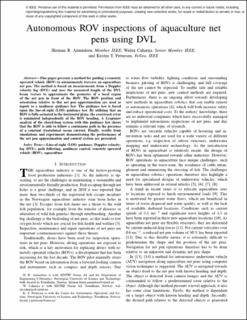| dc.contributor.author | Amundsen, Herman Biørn | |
| dc.contributor.author | Caharija, Walter | |
| dc.contributor.author | Pettersen, Kristin Ytterstad | |
| dc.date.accessioned | 2022-09-27T08:03:57Z | |
| dc.date.available | 2022-09-27T08:03:57Z | |
| dc.date.created | 2021-09-10T12:59:42Z | |
| dc.date.issued | 2021 | |
| dc.identifier.issn | 0364-9059 | |
| dc.identifier.uri | https://hdl.handle.net/11250/3021629 | |
| dc.description.abstract | This article presents a method for guiding a remotely operated vehicle (ROV) to autonomously traverse an aquaculture net pen. The method is based on measurements from a Doppler velocity log (DVL) and uses the measured length of the DVL beam vectors to approximate the geometry of a local region of the net pen in front of the ROV. The ROV position and orientation relative to this net pen approximation are used as inputs to a nonlinear guidance law. The guidance law is based upon the line-of-sight (LOS) guidance law. By utilizing that an ROV is fully actuated in the horizontal plane, the crosstrack error is minimized independently of the ROV heading. A Lyapunov analysis of the closed-loop system with this guidance law shows that the ROV is able to follow a continuous path in the presence of a constant irrotational ocean current. Finally, results from simulations and experiments demonstrating the performance of the net pen approximation and control system are presented. | en_US |
| dc.language.iso | eng | en_US |
| dc.publisher | IEEE | en_US |
| dc.title | Autonomous ROV inspections of aquaculture net pens using DVL | en_US |
| dc.type | Peer reviewed | en_US |
| dc.type | Journal article | en_US |
| dc.description.version | acceptedVersion | en_US |
| dc.rights.holder | © IEEE. Personal use of this material is permitted. Permission from IEEE must be obtained for all other uses, in any current or future media, including reprinting/republishing this material for advertising or promotional purposes, creating new collective works, for resale or redistribution to servers or lists, or reuse of any copyrighted component of this work in other works. | en_US |
| dc.source.pagenumber | 19 | en_US |
| dc.source.volume | 47 | en_US |
| dc.source.journal | IEEE Journal of Oceanic Engineering | en_US |
| dc.source.issue | 1 | en_US |
| dc.identifier.doi | 10.1109/JOE.2021.3105285 | |
| dc.identifier.cristin | 1933263 | |
| dc.relation.project | Norges forskningsråd: 223254 | en_US |
| dc.relation.project | Norges forskningsråd: 256241 | en_US |
| cristin.ispublished | true | |
| cristin.fulltext | postprint | |
| cristin.qualitycode | 1 | |
